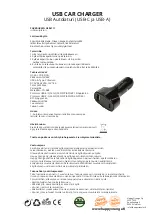
MAN 650067:G
10
DIM
The gauges are designed to dim when the headlights are turned on. This is to reduce the
display intensity at night so the gauges do not cause eye strain or reduced night vision.
Connect this terminal to the tail light or parking light circuit so that it has 12 volts whenever the
headlights are on. When this terminal does not have power, the display system will be at full
brightness. When power is applied, the display dims to an adjustable level.
The night brightness level is adjustable two different ways. This preset brightness is
adjusted in the setup menu “NIGHT”. See ADJ SND for a description of the second method.
By default the system will dim to about ½ brightnes s when DIM terminal gets +12V.
SPD +
This terminal is used to supply power to Dakota Digital speed sensor SEN-01-5. This
supplies 5V DC to the sensor and should not be connected up to anything else. Connect the
RED wire from the SEN-01-5 to this terminal.
If you are using a 1-wire VSS output from a computer or a 2-wire pulse generator, this
terminal should be left open.
***DO NOT use this terminal to power any other devices; it is a low c5V output.
SPD SND
This is where the vehicle speed sensor (VSS) connects. The signal supplied to this
terminal will be used by the control box to calculate the speed reading on the display and also
for calculating and saving odometer reading.
Dakota Digital supplies a 3-wire sensor for most of its kits; SEN-01-5. If you are using
this sensor, the WHITE wire is the speed signal; connect to SPD SND. The RED and BLACK
wires in the cable are power and ground (5V DC) and their connection is discussed in SPD +
and SPD -.
For 2-wire speed sensors such as a cable driven pulse generator, the polarity of the wires
does not matter. Connect one wire to the SPD – (Ground) and the other to the SPD SND
terminal. The speed sensor ground wire should be brought back to the control box to ensure a
proper signal is received. Twisting the ground and signal wires around each other provides an
additional level of interference protection. The speed signal wire should not be routed alongside
tach, ignition, or other high current or high voltage wires.
For vehicles which have a vehicle speed signal from a transmission sensor or ECM, tap
into the VSS wire and connect it to the SPD SND. Consult a vehicle service manual or wiring
diagram to determine wire color and location.
To avoid having to locate a compatible connection, a Dakota Digital BIM-01-1 may also
be used with most 1996 or newer OBDII compliant computer systems to provide a speedometer
reading. When using the BIM-01-1, select “BUS” for the sender setting.
This system can accept 4000 ppm – 128,000 ppm speed signals with room for
adjustment. The speedometer is fully adjustable and calibration is discussed in a later section.
***Failure to calibrate the speedometer may cause your odometer reading to
increase very rapidly if the speedometer is reading too fast.
*** The speed signal wire should NOT be routed alongside ignition components,
tach signal, or other high current/voltage wires.
SPD –
This terminal is used for speed sensor ground. The wire color is BLACK on a 3-wire
sensor. This insures a proper ground as well as providing proper hook-up for a twisted pair of
wires, or a solid state sensor. Only ground the speed sensor here. If you are using a single
wire output from a computer for the VSS then this terminal should be left open.
Содержание 3X Series
Страница 35: ...MAN 650067 G 35 This Page Intentionally Left Blank ...
Страница 36: ...MAN 650067 G 36 ...











































